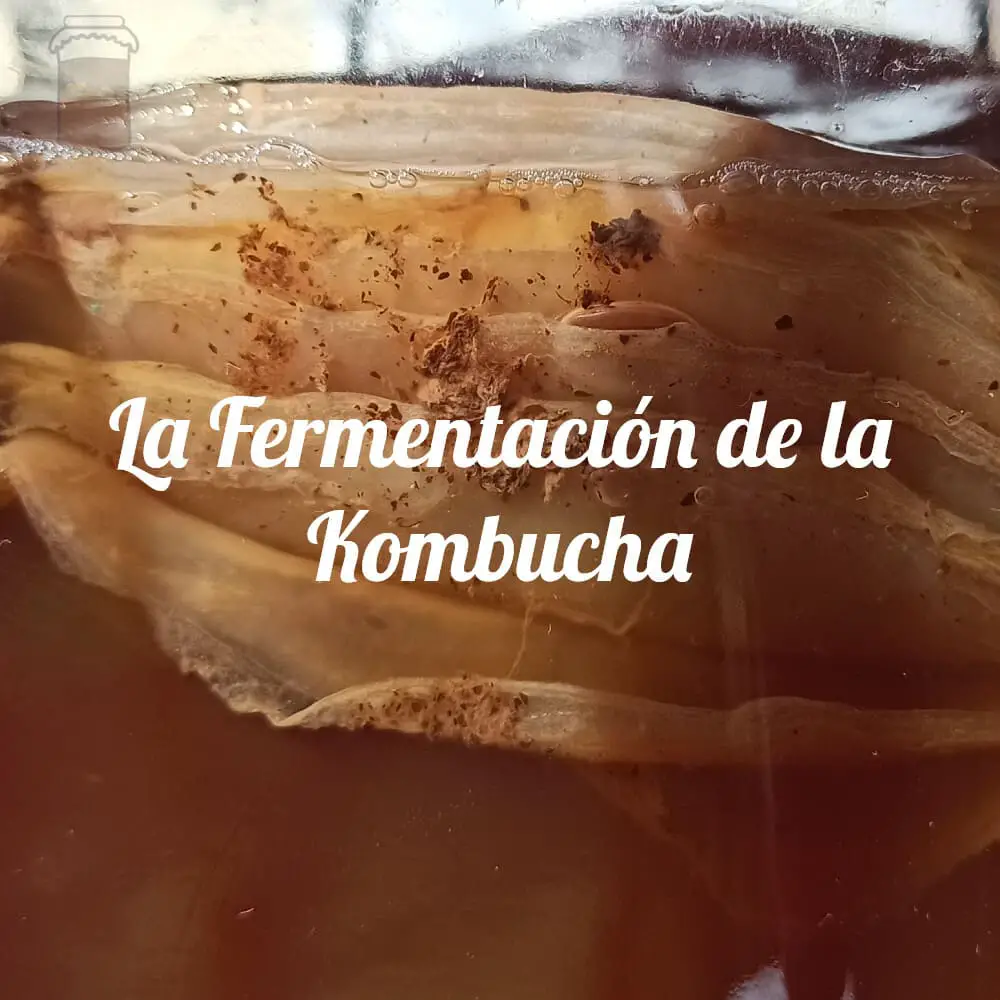Knowing how to control one of the most critical aspects during its preparation, such as fermentation, is vital to make our kombucha.
Fermentation is the process where you can prevent risks or undesirable results when obtaining your drink because if you achieve a successful fermentation, you can get a product of high nutritional quality and with health benefits.
How many fermentation days should you have?
The average fermentation time is 15 days. The culture modifies the nutrients found in the drink. As the fermentation progresses, the available microorganisms will change the metabolites formed, generating kombuchas with different characteristics at the end of fermentation. [1] [2]
The allowed days can range from 7 to 60 days of fermentation. Even so, the final result will be significantly influenced by the duration of fermentation, so within 6 to 10 days, we get a refreshing kombucha with fruit flavor. Still, more than 10 to 15 days dramatically increases the acidity generating a vinegar-flavored drink, as long as the temperatures are ideal. [1]
For example, in my case, when preparing kombucha with green tea in summer, it can be well fermented after eight days. Still, winter may require about three weeks, so the temperature is essential when fermenting kombucha.
With a very long fermentation time, we can make kombucha vinegar, which is very unpleasant to the palate if consumed directly. Increasing the fermentation time can generate a higher concentration of antioxidants but will result in a high amount of organic acids that are harmful to health in large concentrations. [1]
I invite you to read the article on how to prepare kombucha, in case you do not know.
What is the ideal temperature?
Temperatures ranging from 22ºC to 30ºC (70°F – 86°F) are perfect for getting a good kombucha. Even so, some studies showed an ideal fermentation temperature of 25ºC (77°F), allowing researchers to obtain the best product. [1] [3]
Let the broth ferment for ten days. It is best to be at 25ºC since you get a drink of high microbiological and sensory quality. At all temperatures, glucuronic acid (natural detoxifier) increases but reaches the maximum at 25ºC, with rapid sucrose metabolism. [2] [3]
To start fermentation, at least it must be at 20ºC and keep it in a range of 22ºC to 30ºC. If the temperature increases, more organic acids, metabolites, and vitamin C are concentrated. However, if it exceeds the established capacity, ethanol, and acetic acid content can be increased, becoming challenging to consume. [1] [3]
What is the best pH for kombucha?
The most ideal is a pH that does not fall below 3, as lower makes it hard to drink. Remember that the pH of traditional kombucha tends to stabilize in the long term around 2.5, as we saw in the guide on the pH of kombucha.
Achieving adequate acidity will depend on the starter culture used and the measures taken during fermentation. A longer fermentation time increases acetic acid by lowering the pH rapidly. Changes in pH affect the antioxidant activity of the drink, and increased acidity will decrease the alcohol and sweetness of kombucha.
The second fermentation does not generate additional changes to the pH. At this point, there can be no more changes due to the current content of microorganisms and nutrients that do not allow it to decrease further; therefore, the medium now only allows the viability of microorganisms capable of withstanding this acidity, being an excellent protection against invading microorganisms. [4]
How can you flavor your kombucha?
This topic is already exhaustively covered on the website, so I leave you the link on how to improve the flavor of kombucha, but below, the information is summarized.
Fruit juices or pieces of it help improve the flavor of kombucha. Even other ingredients can be mixed, generating complex flavors in a single drink. [5]
After fermentation, you can pass the drink to other jars, leaving a maximum space of 8 centimeters at the top to add the fruit or any other ingredient to generate flavor. You can also color the drink with natural dyes. Let it ferment for three more days while monitoring the accumulation of gases to prevent accidents. [5] [6]
The fruits are liquefied or added in pieces before starting carbonation or second fermentation and sealed well with screw caps that will allow them to release the accumulated gases. See how to gasify kombucha here.
More gluconic acid can be produced depending on the measures taken during fermentation. It has been shown that this substance improves the taste of kombucha and is obtained from the growth of certain microorganisms that significantly increase its concentration in the drink. [7]
Why is fermentation time necessary? How does it work?
A critical point in controlling the sweetness of kombucha is the fermentation time. The concentration of sugars will change as the days of fermentation pass as compounds such as sucrose are metabolized to form other sugars and, later organic acids.
Many people ferment kombucha for only about four days, but that is a mistake since the broth will be very sweet since it has not been fermented, and it is also at a good point for ethanol production. So that’s why those people find it tasteful good.
During fermentation, yeast initially breaks down sugar (sucrose) into fructose, glucose, and ethanol. However, by this time, the bacteria are asleep because the sucrose molecule is too complex to use as food; therefore, the production of organic acids is almost zero.
Then, as days pass by, the bacteria can begin to use the byproducts of the fermentation of the yeasts, in particular glucose and ethanol, producing healthy organic acids such as acetic and glucuronic.
So if kombucha is still sweet, it is very likely that the bacteria are unaware that there is food since the only one’s feeding would be the yeasts. In the post about the alcohol content of kombucha, you can see a graph in the section of how it varies over time that is illustrative regarding fermentation over the days.
How to stop the fermentation of kombucha?
After making our kombucha, there is still the risk that it will continue to ferment, becoming more acidic or increasing the alcohol content, so several methods were considered to completely stop the fermentation, either with temperature or the use of preservatives.
When the fermentation is finished, it is essential to remove the SCOBY. Even so, there may be traces of microorganisms that will continue to metabolize some substances of the drink, gradually changing its composition, which is why it is best to take the broth to the refrigerator, where fermentation will be minimal.
You can use pasteurization or preservatives such as sodium and potassium benzoate, inhibiting or slowing down the growth of microorganisms in the kombucha, thus preventing excess alcohol and CO2 from forming when storing them. But despite being safe methods, the ideal is always to refrigerate. [1]
How to make kombucha in winter?
In winter, it is a problem to ferment our kombucha because the microorganisms are not in the conditions to grow adequately, caused of low temperatures. Hence, nutrient metabolism is slow, and takes a long time to form kombucha tea.
We can have our kombucha ready at a regular or warm room temperature within ten days or less. Still, in cold climates, things are complicated, needing little more than 2 to 3 weeks to ferment it completely, in more extreme cases, months. [5]
It is also recommended to use certain heaters, which stabilize the temperature of kombucha at 25°C, so if you can give yourself the option to buy these devices, you will have optimal kombucha in winter.
If your house has a central heating system, you will probably have no problem fermenting kombucha since you will have some control of the temperature as long as you are in the house. The contribution will be minimal if the temperatures oscillate a lot when turning off the heating.
You have to wait longer to get the desired kombucha.
You can also add more nutrients to keep your SCOBY viable at low temperatures, and you can even swap the broth when it’s fermented for a sweetened tea to keep it active. With these methods, you can prevent your kombucha’s fermentation from slowing down and taking longer to sour. [9] [10]
Adding more starter kombucha to accelerate fermentation is recommended in other cases, although this aspect is not entirely clear.
Precautions for fermentation
You must constantly check the broth and keep it in the necessary conditions to avoid fermentation altered by the weather or contaminants. Utensils and jars must be disinfected or sterilized, and prepare kombucha in a hygienic space.
It would be best to use the appropriate containers with quality glass or stainless steel to prevent poor fermentation and decrease the risk of accidental contamination.
If you do not take the necessary hygienic measures, the drink will likely be contaminated with dangerous pathogens. Even
Bacillus anthrax, Penicillium, and Aspergillus have been found in kombucha drinks under unsanitary conditions. [1]
Kombucha can go through secondary anaerobic fermentation that would increase alcohol and lactic acid levels. If you do not drink your kombucha quickly, you should be aware that, even refrigerated, microorganisms can continue to grow slowly and gradually change the drink’s composition.
If you do not stop it entirely by eradicating microorganisms, it is better not to keep it for a long time. [10]
Check out more content below.
[1] https://www.sciencedirect.com/science/article/pii/S2772753X22000144
[2] https://www.sciencedirect.com/science/article/abs/pii/S0168160515301951
[3] https://www.tandfonline.com/doi/full/10.1080/19476337.2017.1321588
[4] https://www.ncbi.nlm.nih.gov/pmc/articles/PMC7278673/
[5] https://www.mdpi.com/2306-5710/6/1/15/htm
[6] https://extension.usu.edu/preserve-the-harvest/kombucha
[7] https://www.sciencedirect.com/science/article/pii/S0023643821020909
[9] https://www.dummies.com/article/home-auto-hobbies/food-drink/fermenting/10-tips-for-troubleshooting-the-fermented-food-you-make-160524/
[10] https://www.scienceandfood.org/kombucha-brewing-the-process/

